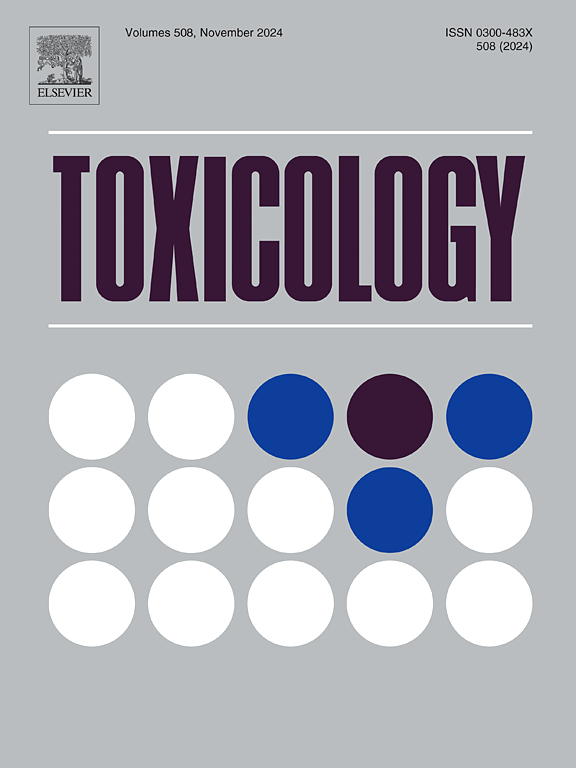Integration of vitro models with machine learning and epidemiological data reveals PCB-induced glucose metabolism disruption linked to mitochondrial dysfunction
IF 4.6
3区 医学
Q1 PHARMACOLOGY & PHARMACY
引用次数: 0
Abstract
Polychlorinated biphenyls (PCBs) have been reported to be associated with type 2 diabetes mellitus (T2DM); thus, the knowledge of their endocrine disruption mechanisms would be vital for assessing health risks. This study revealed the potential mechanism of abnormal glucose metabolism due to acute PCB-153 exposure in HepG2 cells through integrated transcriptome and DNA methylation analysis. Based on a joint analysis of two omics, the random forest machine learning model was established with 200 trees and cross-validated five times. Potential biomarkers identified by machine learning pointed to impaired mitochondrial function. Subsequent validation confirmed PCB-153-induced mitochondrial dysfunction, evidenced by reduced mitochondrial DNA copy number (mtDNAcn), adenosine triphosphate (ATP) production, mitochondrial membrane potential, and ATPase activity, alongside altered morphology and elevated reactive oxygen species (ROS). Critically, abnormal glucose metabolism was significantly attenuated and even recovered to control levels after enhancement of mitochondrial function, suggesting that PCB-153 promoted glucose metabolic defects in relation to mitochondrial dysfunction. The decline of mtDNAcn in the T2DM nested case-control population provided further evidence for long-term PCBs exposure inducing mitochondrial dysfunction. In addition, significant multiplicative and additive interactions were observed between mtDNAcn and PCB-138, PCB-153, lowly chlorinated PCBs, highly chlorinated PCBs, ΣNDL-PCBs on the 5-year FBG levels changes (Pinteraction: 0.004–0.03; RERI: −0.44 to −0.31; AP: −0.39 to −0.21). Our findings highlighted the importance of maintaining normal mitochondrial function in glucose metabolism of non-dioxin-like PCBs exposure and provided new insights into T2DM pathogenesis caused by PCBs exposure.
结合机器学习和流行病学数据的体外模型显示,多氯联苯诱导的葡萄糖代谢紊乱与线粒体功能障碍有关
据报道,多氯联苯(PCBs)与2型糖尿病(T2DM)有关;因此,了解其内分泌干扰机制对于评估健康风险至关重要。本研究通过整合转录组和DNA甲基化分析揭示了HepG2细胞急性暴露于PCB-153导致糖代谢异常的潜在机制。基于两组学的联合分析,建立了包含200棵树的随机森林机器学习模型,并进行了5次交叉验证。通过机器学习识别的潜在生物标志物指向线粒体功能受损。随后的验证证实了pcb -153诱导的线粒体功能障碍,其证据包括线粒体DNA拷贝数(mtDNAcn)、三磷酸腺苷(ATP)生成、线粒体膜电位和ATP酶活性降低,以及形态改变和活性氧(ROS)升高。更为关键的是,线粒体功能增强后,异常的糖代谢显著减弱,甚至恢复到控制水平,这表明PCB-153促进了与线粒体功能障碍相关的糖代谢缺陷。T2DM嵌套病例对照人群mtDNAcn的下降为长期暴露于多氯联苯诱导线粒体功能障碍提供了进一步的证据。此外,mtDNAcn与PCB-138、PCB-153、低氯化多氯联苯、高氯化多氯联苯、ΣNDL-PCBs在5年FBG水平变化上存在显著的乘法和加性相互作用(p相互作用:0.004-0.03;RERI:−0.44至−0.31;AP:−0.39至−0.21)。我们的研究结果强调了在非二恶英样多氯联苯暴露的糖代谢中维持正常线粒体功能的重要性,并为多氯联苯暴露引起的T2DM发病机制提供了新的见解。
本文章由计算机程序翻译,如有差异,请以英文原文为准。
求助全文
约1分钟内获得全文
求助全文
来源期刊

Toxicology
医学-毒理学
CiteScore
7.80
自引率
4.40%
发文量
222
审稿时长
23 days
期刊介绍:
Toxicology is an international, peer-reviewed journal that publishes only the highest quality original scientific research and critical reviews describing hypothesis-based investigations into mechanisms of toxicity associated with exposures to xenobiotic chemicals, particularly as it relates to human health. In this respect "mechanisms" is defined on both the macro (e.g. physiological, biological, kinetic, species, sex, etc.) and molecular (genomic, transcriptomic, metabolic, etc.) scale. Emphasis is placed on findings that identify novel hazards and that can be extrapolated to exposures and mechanisms that are relevant to estimating human risk. Toxicology also publishes brief communications, personal commentaries and opinion articles, as well as concise expert reviews on contemporary topics. All research and review articles published in Toxicology are subject to rigorous peer review. Authors are asked to contact the Editor-in-Chief prior to submitting review articles or commentaries for consideration for publication in Toxicology.
 求助内容:
求助内容: 应助结果提醒方式:
应助结果提醒方式:


